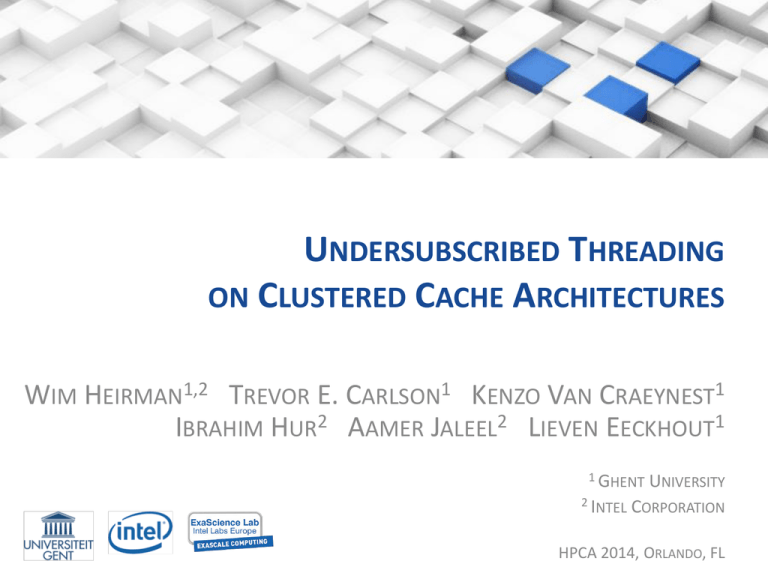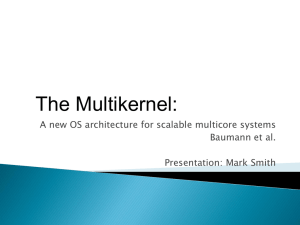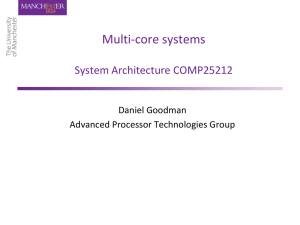Undersubscribed Threading on Clustered Cache Architectures
advertisement

UNDERSUBSCRIBED THREADING ON CLUSTERED CACHE ARCHITECTURES WIM HEIRMAN1,2 TREVOR E. CARLSON1 KENZO VAN CRAEYNEST1 IBRAHIM HUR2 AAMER JALEEL2 LIEVEN EECKHOUT1 1 GHENT 2 INTEL UNIVERSITY CORPORATION HPCA 2014, ORLANDO, FL CONTEXT • Many-core processor with 10s-100s of cores – E.g. Intel Xeon Phi, Tilera, GPGPU • Running scalable, data-parallel workloads – SPEC OMP, NAS Parallel Benchmarks, … • Processor design @ fixed area/power budget – Spend on cores, caches? – Cache topology? 2 OVERVIEW • Cache topology: – Why clustered caches? – Why undersubscription? • Dynamic undersubscription – CRUST algorithms for automatic adaptation • CRUST and future many-core design 3 MANY-CORE CACHE ARCHITECTURES private Core Core Core Core Core Core Cache Cache Cache Cache Cache Cache Core Core clustered shared (NUCA) … (C) Core Cache Core Core Core … (C) Cache Core Core Core … (N) Core … (N/C) … (N) Cache 4 MANY-CORE CACHE ARCHITECTURES hit latency private sharing clustered … … shared … 5 UNDERSUBSCRIBING FOR CACHE CAPACITY • Less than C active cores/threads per cluster • When working set does not fit in cache • Keep all cache capacity accessible 3/4full 2/4 1/4 undersubscription subscription Core Core Core Cache Core Core Core Core Cache Core … (N) 6 MANY-CORE CACHE ARCHITECTURES hit latency private sharing undersubscription (1:1) clustered … … (1:C) shared … (1:N) 7 PERFORMANCE & ENERGY: WORKING SET VS. CACHE SIZE Baseline architecture: • 128 cores • private L1 • clustered L2 1M shared per 4 cores energy efficiency (1/energy) normalized performance (1/execution time) N-cg/A 1/4 2/4 3/4 4/4 8 PERFORMANCE & ENERGY: WORKING SET VS. CACHE SIZE 3/4 4/4 2/4 3/4 4/4 performance energy efficiency 1/4 energy efficiency N-ft/C performance energy efficiency performance 2/4 1/4 undersubscription: 3.5x performance 80% energy savings N-cg/C N-cg/A 1/4 Capacity bound: reduce thread count to optimize hit rate Bandwidth bound: disable cores for better energy efficiency Compute bound: use all cores for highest performance 1/4 2/4 3/4 4/4 9 CLUSTER-AWARE UNDERSUBSCRIBED SCHEDULING OF THREADS (CRUST) • Dynamic undersubscription • Integrated into the OpenMP runtime library – Adapt to each #pragma omp individually • Optimize for performance first, save energy when possible – Compute bound: full subscription – Bandwidth bound: no* performance degradation (* <5% vs. full) – Capacity bound: highest performance • Two CRUST heuristics (descend and predict) for on-line adaptation CRUST-descend CRUST-predict 10 CRUST-DESCEND • Start with full subscription • Reduce thread count while performance increases Selected performance 3 5 4 2 1 full threads/cluster 11 CRUST-PREDICT • Reduce number of steps required by being smarter • Start with heterogeneous undersubscription – Measure LLC miss rate for each thread/cluster option – Predict performance of each option using PIE-like model • Select best predicted option 12 METHODOLOGY • Generic many-core architecture – – – – – – 128 cores, 2-issue OOO @1GHz 2x 32 KB private L1 I+D L1-D stride prefetcher 1 MB shared L2 per 4 cores 2-D mesh NoC 64 GB/s total DRAM bandwidth • Sniper simulator, McPAT for power • SPEC OMP and NAS parallel benchmarks – Reduced iteration counts from ref, class A inputs 13 RESULTS: ORACLE (STATIC) capacity bound bandwidth bound compute bound 14 RESULTS: LINEAR BANDWIDTH MODELS capacity bound bandwidth bound compute bound Linear Bandwidth Models (e.g. BAT): save energy, does not exploit capacity effects on clustered caches 15 RESULTS: CRUST capacity bound bandwidth bound compute bound CRUST: save energy when bandwidth-bound, exploit capacity effects on clustered caches 16 UNDERSUBSCRIPTION VS. FUTURE DESIGNS • Finite chip area, spent on cores or caches – Increasing max. compute vs. keeping cores fed with data • Undersubscription can adapt workload behavior to the architecture Does this allow us to build a higher-performance design? • Sweep core vs. cache area ratio for 14-nm design – Fixed 600 mm² area, core = 1.5 mm², L2 cache = 3 mm²/MB – Clustered L2 shared by 4 cores, latency ~ log2(size) – 1 GB @ 512 GB/s on-package, 64 GB/s off-package Variant A B C D E F Cores 96 128 160 192 224 256 L2 size (MB/core) 1.5 1.0 0.8 0.5 0.4 0.3 25% 33% 40% 50% 58% 64% Core area 17 UNDERSUBSCRIPTION FOR FUTURE DESIGNS Compute bound: linear relation between active cores and performance Capacity bound: reduce thread count until combined working set fits available cache N-ft/C 18 UNDERSUBSCRIPTION FOR FUTURE DESIGNS • Build one design with best average performance • Full subscription: – conservative option C has highest average performance • Dynamic undersubscription: prefer more cores E vs. C: 40% more cores, higher max. performance for compute-bound benchmarks 15% higher performance relative performance – – use undersubscription to accomodate capacity-bound workloads 1.54 2.0 full subscription 1.0 dynamic subscription 1.24 0.0 A B C D E F 19 CONCLUSIONS • Use clustered caches for future many-core designs – Balance hit rate and hit latency – Exploit sharing to avoid duplication – Allow for undersubscription (use all cache, not all cores) • CRUST for dynamic undersubscription – Adapt thread count per OpenMP parallel section – Performance and energy improvements of up to 50% • Take undersubscription usage model into account when designing future many-core processors – CRUST-aware design: 40% more cores, 15% higher performance 20








